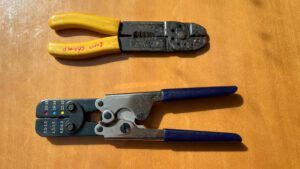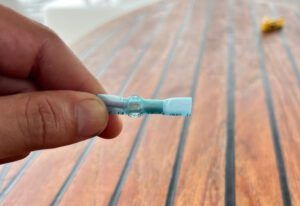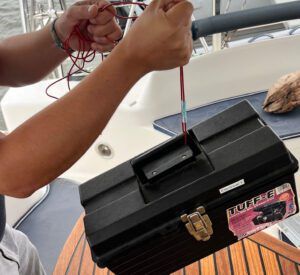If you own a cruising boat, you will have to learn to be an electrician (in addition to a painter, a detailer, a mechanic, a rigger and a plumber…).
I’ve had one marine electrician that I’ve worked with that I would trust with almost anything on Confianza, but he is quite expensive. I’ve had another who has very respectable knowledge, but I had to constantly chase him to actually show up. And I mean constantly.
It was very frustrating because he was helping me install the lithium battery bank and charging system. What should have taken a week took six.
As usual, I find myself preferring to do the work myself, and with the amount of modifications and upgrades that are electrical, I have spent probably more time on electrical than anything else on the boat.
MY EARLY WORK WAS AWFUL
I have to admit, my early work on Confianza still makes me cringey. Planning was poor, cable organization a mess and too much “good enough is good enough” attitude. That approach, at best, leads to thrice the work in the future and, at worst, it could lead to a fire.
I inherited quite the plethora of tools when we bought Confianza from the previous owners. They had spent many years sailing all around the globe, so I had an inherent trust of the tools that got them there.
But I was finding that my electrical work over the years was not lasting the test of time (and elements). Years ago, I replaced all the interior lights with LEDs (25 or so) to give us much more usability out of the legacy lead-acid battery setup. Five years later, one started flickering, then another, then another, four flickering now and the co-captain was not pleased with my work after all.
THE RIGHT TOOLS FOR THE JOB
Having the right tools makes jobs take less time both during the repair itself and also over the course of the total maintenance time of a boat’s lifecycle. It’s not just about efficiency—proper repairs are also important to ensure safety. Making bad crimps can trigger problems like corrosion, disconnected wires and even dangerous shorts circuits.
Corrosion leads to voltage drops that cause intermittent issues and damages more sensitive electronics. Corrosion also causes higher resistance and higher resistance creates heat.
It’s not that I was consciously lazy when crimping, I was just using the wrong tool.
THE WRONG TOOL FOR THE JOB

Can you guess which one?
The top one is a $30 SUPER CHAMP crimper that came with the boat. It’s also the one I generally see in everyone’s toolbox that I lend a hand to.
The results from this tool are very subpar. The crimps it makes are thin enough to cut through the shrink wrap if you’re not careful, which will give the crimp a short life. You’ll also need to double crimp each side, so that means four chances of damaging the heat shrink. It’s also very challenging to apply the right amount of force for a proper crimp.
The bottom one is a Sea-Dog Heat Shrink Terminal Crimper, which also can be regularly found at around $30.
“Wait, you’re not going to recommend a crimper that costs real boat dollars?”
In my experience, this crimper, which I believe is a copycat of the FTZ Industries / FTZ Electrical Control Cycle Ratcheting Crimp tool, does a very fine job. Fun fact, FTZ was actually the inventor of the heat shrink terminal itself, according to Rod at Compass Marine.
The ratchet action forces you to actually put enough pressure on the crimp before it will release, giving you a great crimp every time. It will not release until you have crimped down all the way.

With the old crimpers, I was definitely not crimping hard enough (for fear of cutting the heat shrink). The new crimpers even took some getting used to with how much you will squish the wires. When you cut off a cross section of the crimp, you can see the wire strands have been squished into almost a solid wire, making a connection that will last a long time.
The ABYC specifications for a crimp on a 14-gauge wire to resist 30 pounds of pull force. I didn’t have a 30-pound weight laying around, but I did have a heavy toolbox in front of me.

Not an exact science here, mind you, but it looks good to me!
Is there any reason to spend more on a crimper? After spending far too much time researching crimpers, I found negative reviews on nearly all of the crimpers in the $100 price range. Why bother? When you get above the $175 mark, you can start into the professional grade, but it seems quite overkill for the average cruiser and tinkerer. I’ve not yet had any problems with a crimp made from the Sea-Dog.
WIRE STRIPPING
My old SUPER CHAMP had a wire stripper built right in. Wasn’t that more convenient? Well, no, actually. I’m not sure how many times I had to re-do a wire stripping because I realized I had taken some of the wire itself off with it.
“Ok, this is where we break out the big bucks then?”
Nope. My favorite is the Irwin Vise-grip Wire Stripper ($25).

This stripper automatically adjusts to the gauge, clamps on and strips the wire with a quick squeeze. The yellow plastic guide piece is how you set how long of an exposed end you are looking for. In this video below, I tried to squeeze it slowly so you can get an idea of how it works.
In normal use, it’s very quick and convenient. A closeup might paint a better picture of the action:
“An automatic? Oh come on, those automatic strippers are garbage! Get a real crimper! Like the IDEAL 45-092 Stripmaster!”
Ok, yes, most of the automatic strippers are total garbage. I have bought multiple different brands throughout the years, and most have broken. I even listened to a pitch from a guy at the Annapolis boat show claiming his company had fixed all the problems, and it will work forever! I bought two, and both broke within 6 months.
The convenience factor is just worth it. I’m sure it’s not rugged enough for a daily driver, but I’ve been using this one for over two years, and it has held up nicely. Clean strips and no broken wire strands.
If you are worried about longevity and perfection over convenience, just go with the IDEAL 45-092 Stripmaster ($45). I have one of those as well as a backup.
Hope this was helpful for cruisers that don’t want to break the bank but want to have their electrical connections last a long time. Happy stripping and crimping!
Video caption: Closeup of Irwin Vise-Grip automatic wire stripper in action. (Video/ Adam Morris)
Note: I/we are not sponsored by any companies mentioned in this article. We cruise full time on our test bed, Confianza, and we enjoy sharing our tests and opinions to give back to the community.






































I too had something similar to the Super Champ. It is one of very, very few tools that I have consigned to the trash without it being broken or worn. It just didn’t work.
Logged in and can’t access anything
Same issue as Stewart logged in and can’t access this article
I’m a retired Commercial Aircraft Mx Technician who for the last 46+ years did a lot of electrical repairs on Boeing Freighter Jets, I always used the Ideal 45-092, on every teflon coated wire from 8- 22 gauge wire connection or repair, without any complications or damage to the internal wire strands.
For any crimping i used a Klein 3005CR. This does not damage the external shielding. Oh yea I always also covered the connection with heat shrink tubing to insure an extra moisture barrier to the connection.
Having rewired a number of boats I found this article helpful.
A ratchet crimper is always superior to the cheap auto parts store variants, but on heavier cables, such battery and inverter crimps I found inexpensive Harbor Freight Tool hydraulic crimpers to do a great job of crimping heavier cables securely. Then using shrink tubing to finish the job.
On regular wiring I use shrink wrap marine connectors, a good crimper will not damage the shrink tubing. I always use an electric heat gun as flame type torches can easily damage the shrink tubing.
There are more expensive hydraulic crimpers but the Harbor Freight version has served me well for a number of years, unless your a professional marine electrician it’ll do everything you need it to. I was popular in the islands when people found out I had hydraulic crimpers, they got a lot of use and still work well.